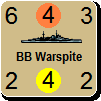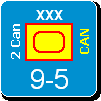Extraneous
Posts: 1810
Joined: 6/14/2008
Status: offline

|
öEngine(s) output: 82,500 hp
¡öTop Speed: 32.5 knots
¡öMain armament: 12 x 6-inch (152mm), 8 x 4-inch (102mm) guns
¡öDisplacement (full load): 11,650 tons
¡öThickest armour: 4.5-inches (belt)
The Town-class comprised ten light cruisers that were built for the Royal Navy (RN) during the thirties. The Towns were divided into three sub-groups; Southampton (5 ships), Gloucester (3 ships) and Edinburgh (2 ships).
In the early thirties, the British ceased building larger 8-inch gun cruisers and instead concentrated upon the construction of smaller 6-inch gun vessels. The latter allowed more ships to be built within the tonnage restrictions of the various naval treaties. The ability to build more cruisers was important for the United Kingdom given that she had a large overseas empire to protect and it was considered by the Admiralty that at a very minimum, seventy cruisers were required.
The Towns were larger cruisers than the British ideally wanted to build, but were designed in response to the Japanese Mogami-class, which originally featured fifteen 6.1-inch guns on a declared 8,500 ton displacement.
The Gloucesters were slightly enlarged versions of the Southamptons and their main armament remained the same; namely twelve 6-inch guns fitted in four triple turrets. Secondary armament too was unchanged from the earlier ships and featured eight, high-angle, 4-inch guns mounted in four twin turrets. Four 3-pdrs and two quadruple 2-pdr pompoms provided close range anti-aircraft (AA) weaponry. Two triple torpedo tubes rounded off the weapons package. Up to three aircraft could be carried.
During the war, the AA weaponry on both Manchester and Liverpool was increased (Gloucester was sunk before any additions could be carried out). Liverpool required substantial repairs to battle damage incurred in 1942 and underwent a comprehensive refit that involved removal of her X-turret and her aircraft carrying capability.
One of the big improvements that the Gloucesters benefitted from over the Southamptons was an increase in armour protection. The belt protection remained the same at 4.5-inches, with box protection around the ammunition spaces to the same thickness. However the turret armour was increased, as was the deck armour over the machinery spaces.
Top speed was slightly increased thanks to the fitting of more powerful machinery and a respectable 32 knots could be comfortably achieved.
All Town class ships were named after major English, Scottish and Irish towns (note: the Welsh capital Cardiff had already been used for one of the C-class cruisers).
HMS Manchester was completed in August 1938. At the outbreak of World War II she was operating in the Indian Ocean where she was deployed for the interception of blockade runners and commerce raiders. In October, she returned to the UK to join the 18th Cruiser Squadron (CS) and arrived there the following month. She was immediately sent to the dockyard for a refit.
From January 1940 until the German invasion of Norway in April, Manchester was deployed on interception and patrol duty in the North Western Approaches and the North Sea. In February, she took part in the search for six German merchant ships that had previously sailed from Vigo, Spain and were trying to get back to Germany. Only one enemy ship reached Germany (see HMS York).
Following the German invasion of Denmark and Norway in April 1940, Manchester took part in the ill-fated Norwegian Campaign (see HMS Renown, HMS Valiant and HMS Curacoa). Events soon turned sour for the Allies and for two days from the 30th of that month, the RN was used to evacuate Sickelforce. Sickelforce was the southern prong of a pincer movement originally ordered to take the town of Trondheim in central Norway. The evacuation took place from the nearby ports at Molde and Andalsnes using the transports Ulster Monarch and Ulster Prince. They were escorted that first night by the cruisers Arethusa, Sheffield and Southampton with six destroyers. The following night the cruisers Birmingham, Manchester, Calcutta and the sloop Auckland, removed the remaining men. The cruiser Glasgow evacuated the Norwegian King and his entourage, taking them to Tromso in northern Norway. Then between the 30th April and the 3rd May, the northern prong, Mauriceforce, was evacuated from Namsos. The cruiser Carlisle provided AA defence during this operation which was carried out by the heavy cruisers Devonshire and York; the French cruiser Montcalm; three French auxiliary cruisers and eight British and French destroyers. Two of these destroyers, Bison and Afridi were lost to air attack on the 3rd.
The successful evacuation from Namsos of so many men was in great part due to the actions of men like Lt-Cdr Richard Stannard V.C of the Royal Naval Reserve, whose command was under air attack for five days continuously as the Germans harassed the Allied forces. He commanded the trawler HMS Arab, part of the 15th Anti-Submarine Striking Force. HMS Arab was too small a vessel to be represented in World In Flames and so Stannard's story is told here.
Enemy bombing attacks had set fire to the wharf at Namsos and with no water supply available on shore, Stannard rammed the wharf and held Arab firmly against the structure while he tried for two hours to extinguish the fire with hoses from his ship. He only gave up when the situation became hopeless. He then set up an armed camp on shore using the crews of Arab and other ships. This was a well placed redoubt where the men could continue the fight against the incessant enemy air attacks. At one stage another trawler was hit and set on fire and Stannard led two other men aboard the burning vessel and moved her away from the other ships to save them from destruction when the first ship eventually blew up. When it was time to leave the fjord, a German bomber attacked Arab. Stannard waited until the bomber was within 800 yards, and then coolly brought the German aircraft down. Against all odds, HMS Arab was brought home and for his bravery, Stannard won the VC, the highest award for bravery in the face of the enemy.
Manchester left Norway before the final evacuation from Narvik; with the situation in France deteriorating, she was deployed on anti-invasion patrol off the east coast of England. On the 9th May she was involved in a brief skirmish with German S-boats (see HMS Birmingham) and she remained on anti-invasion duty until she was taken for a refit in July. Upon completion, she was deployed once more to repulse any invasion threat, and she continued in this role until, with the invasion threat receding and the Italians now in the war, Manchester was transferred to the Mediterranean in November 1940.
Manchester's first operation in her new theatre was Collar, a multi-pronged operation in which she was charged with carrying reinforcements for the island of Malta (see HMS Despatch). Her stay in the Mediterranean was brief however, and she was back in the UK for a refit at the start of 1941. Manchester was ready to join the Home Fleet in April and was deployed on patrol in northern waters.
On the 7th May, Manchester, Birmingham, Edinburgh and four destroyers were sent to intercept the German weather ship M¨¹nchen which was operating off Jan Mayen Island in the Arctic. The purpose of this operation was to get hold of German secret Enigma equipment. The destroyer Somali was able to surprise the German crew and a raiding party was sent on board before M¨¹nchen could be scuttled. A Short Weather Cipher Book and Enigma rotor settings were captured in the operation.
At the end of that month, Manchester was sent to patrol the Iceland-Faroes gap and she was there during the breakout of the German battleship Bismarck and the heavy cruiser Prinz Eugen (see HMS Hood and HMS Rodney). After Bismarck was sunk Manchester resumed duty in northern waters until July, when she was sent back to the Mediterranean once more.
In July 1941, the RN escorted a convoy to Malta under the codename Substance. As part of this operation, empty ships were also returned to Gibraltar from the island. The Mediterranean Fleet also sailed from Alexandria during the operation as a diversion to assist Substance. The Malta bound convoy began in the UK and was escorted by Manchester, Arethusa, the minelayer Manxman and five destroyers. Amongst the convoy was the troopship Pasteur which transferred its passengers to the two cruisers upon reaching Gibraltar. From Gibraltar, the merchant ships and their escorts left for Malta on the 21st. The convoy was made up of six freighters and the small troopship Leinster, although the latter ran aground and so could not take part in the operation.
The first ships to sail were the oiler Brown Ranger and a destroyer escort. Brown Ranger provided refuelling capability for the destroyers. The main convoy followed with an escort made up of Edinburgh, Manxman and five destroyers. They were then met by Manchester, Arethusa and a further four destroyers. Finally, Force H, consisting of the aircraft carrier Ark Royal, the battleship Nelson, the battlecruiser Renown, the cruiser Hermione and seven destroyers provided the distant covering role. The following day, the seven empty merchant vessels sailed from Malta and headed west with a destroyer escort. They then separated into three groups, according to their speed and all seven made it back to Gibraltar, although one was damaged in an air attack.
As expected, the first sign of enemy aircraft came one day out of Gibraltar and the convoy was subject to heavy air attacks from mid-morning. Torpedoes hit both Manchester and the destroyer Fearless. Fearless had to be sunk by her sister Forester as she was too badly damaged to continue. Manchester was able to turn around and head back for Gibraltar, escorted by the destroyer Avon Vale, at a speed of around 8 knots. The two ships were attacked on their return journey but were able to beat off the attacking aircraft. Meanwhile, the convoy continued west and the next ship to be hit was the destroyer Firedrake, which was providing minesweeping duty ahead of the convoy. She too had to be towed back to Gibraltar.
As was usual practice, the ships of Force H returned to Gibraltar before the Sicilian Narrows to allow the cruisers and destroyers to escort the convoy on the final leg of the journey to Malta. Hermione was detached from Force H to join the convoy in place of Manchester. The next attacks came that night, this time from Italian motor torpedo boats. The freighter Sydney Star was hit, although she was able to continue toward her destination. The following morning, Arethusa, Edinburgh and Manxman detached from the convoy and sailed at top speed for Malta, which they reached around midday, and disembarked their troop cargo. At around 1600hrs the merchant ships arrived. With the job done, the escorts left Grand Harbour that evening and returned to Gibraltar. As for Manchester, having received temporary repairs at Gibraltar, she was then ordered to the U.S where more permanent repairs were carried out.
Repair work was completed in March 1942 and after briefly being deployed in Arctic waters as part of the distant cover for the ill-fated convoy PQ17 (see ASW Counter 4701), Manchester was ordered back to the Mediterranean where the supply situation on Malta was becoming critical.
It was there, in August 1942, that Manchester carried out her last operation; taking part in perhaps the most famous convoy operation of them all, the Malta relief convoy, Operation Pedestal (see HMS Sirius). In the early hours of the 13th August, with the convoy off the island of Pantellaria, Manchester fell victim to an attack by two Italian E-Boats, MAS16 and MAS22. One torpedo hit the cruiser's aft machine room, causing serious flooding and damaging her propeller shafts. Controversially, her captain decided that the chances of saving her were too small given her proximity to enemy airfields and the approach of daylight. In order to ensure that her radar did not fall into enemy hands, Captain Drew ordered her scuttling that morning. HMS Manchester was the largest vessel lost to Motor Torpedo Boats during the Second World War.
_____________________________
University of Science Music and Culture (USMC) class of 71 and 72 ~ Extraneous (AKA Mziln)
|
 Printable Version
Printable Version








 well of course - but I am not going to put that in the write-up, because while it might be a good guess, it might also be total nonesense - that's why I asked for help.
well of course - but I am not going to put that in the write-up, because while it might be a good guess, it might also be total nonesense - that's why I asked for help.
 .
.



 New Messages
New Messages No New Messages
No New Messages Hot Topic w/ New Messages
Hot Topic w/ New Messages Hot Topic w/o New Messages
Hot Topic w/o New Messages Locked w/ New Messages
Locked w/ New Messages Locked w/o New Messages
Locked w/o New Messages Post New Thread
Post New Thread